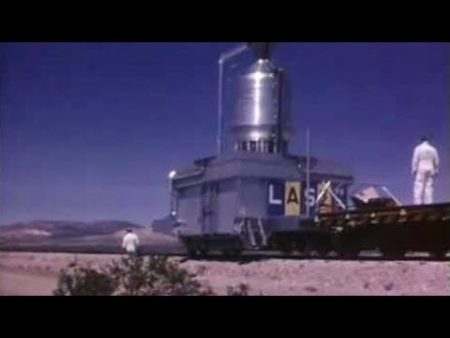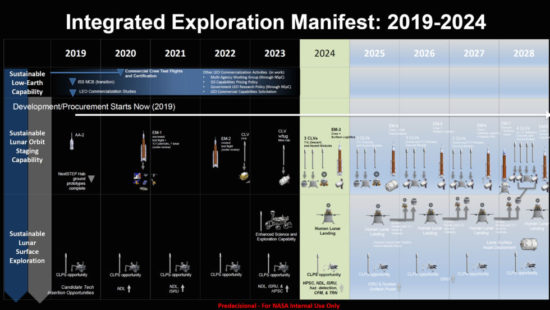August 1, 2019 – This week NASA entered into 19 partnerships with 10 American companies focused on the advancement of space infrastructure. One of those partnerships will involve the building of refueling stations in orbit for space travel. Without the further development of non-chemical propulsion technologies, the human space endeavour will continue to have to rely on fuels like kerosene, hydrogen, and other combustible liquids that provide enough energy to warrant their use as propellant.
In the NASA announcement, the trend to develop new technologies in partnership with commercial operators continues to grow. Among the propulsion initiatives is one to work with SpaceX on advancing the technology for propellant storage and transfer in orbit. SpaceX, in its Starship program, intends to rely on orbital refueling to get to lunar and Martian space.
Missing from these announcements is the further development of nuclear-powered propulsion, something NASA mothballed with the NERVA project back in the 1970s. Roscosmos, Russia’s space agency, has indicated very recently, interest in nuclear-powered propulsion, something the Soviet Union had abandoned as well in the late 20th century. Elon Musk of SpaceX, however, in this last month has called on NASA to revitalize its nuclear-powered rocket project with Mars in mind.

Why are Roscosmos and SpaceX interested in the nuclear option now?
When Werner Von Braun, after the lunar landing in 1969, proposed to NASA the use of nuclear-powered rocket boosters to get to Mars, there was little interest as the Vietnam War made human travel to the planets a low funding priority. Our reliance on chemical rockets in the post-Saturn-V era became the defacto method of propulsion.
But in May of this year, the U.S. Congress authorized up to $225 million for research into nuclear thermal propulsion stating its goal to see a demonstration flight by 2024.
A nuclear-thermal propulsion system would minimally provide twice the propulsive force of any chemical engine. There were even designs capable of much greater propulsive force using the timed explosions of small nuclear bombs to achieve 1,000% greater efficiency.
Nuclear-thermal rockets if built would not be assembled and launched from Earth. Instead, they would be shipped in pieces to low-Earth orbit for assembly. A nuclear-powered rocket would bring the time of transit for a mission to Mars from six months to less than 100 days. And using the small nuclear bomb-powered rocket it would mean reducing the time to less than one month.
For crew health and safety, even with some potential radiation from the nuclear engines, space travelers would be dramatically less exposed to cosmic radiation and its health impacts.
That’s why when the announcements of new industry partnerships for the Moon and Mars were made on July 30th, I was surprised to see no mention of nuclear propulsion projects.
Instead, other than the gas station project, the partnerships and projects announced included the following:
Advanced Communications, Navigation and Avionics
- Advanced Space of Boulder, Colorado, to partner with NASA on lunar navigation technologies and improvements to the Deep Space Network.
- Vulcan Wireless of Carlsbad, California, to test a CubeSat radio transponder and its compatibility with the Deep Space Network.
Advanced Materials
- Aerogel Technologies of Boston to work with NASA on flexible aerogels for rocket fairings and other aerospace uses.
- Lockheed Martin of Littleton, Colorado, to work with NASA on metal powders to be used in spacecraft design.
- Spirit AeroSystem Inc. of Wichita, Kansas, to work with NASA to improve the durability of low-cost reusable rockets using friction-stir welding in construction.
Entry, Descent, and Landing
- Anasphere of Bozeman, Montana, to test a hydrogen generator for inflating heat shields for payload delivery protection on flights to Mars.
- Bally Ribbon Mills of Bally, Pennsylvania, to perform thermal testing on a new seamless weave for a mechanically deployable carbon fabric heat shields.
- Blue Origin of Kent, Washington, to enhance the navigation and guidance systems for precision landings on the Moon.
- Sierra Nevada Corporation of Sparks, Nevada, to develop two entry, descent and landing projects including infrared image capture of the company’s Dream Chaser spacecraft upon re-entry into the Earth’s atmosphere, and development of a method to recover the upper stage of a rocket using a deployable decelerator.
- SpaceX of Hawthorne, California, to work with NASA to further advance vertical landing for large rockets on the Moon including modeling to assess engine plume interactions with lunar regolith.
In-Space Manufacturing and Assembly
- Maxar Technologies of Palo Alto, California, to build a prototype for radio antenna electronics to reduce weight and payload package sizes for deployment on new exploratory missions.
Electric Power
- Blue Origin to partner with NASA on the fuel cells to be used to power the Blue Moon lander to ensure operational continuity for the two weeks of lunar night.
- Maxar to test flexible, lighter, and more powerful solar panels for use on future spacecraft.
Propulsion
- Aerojet Rocketdyne of Canoga Park, California, to design and manufacture a lightweight rocket engine combustion chamber scalable for different missions by using innovative processes and materials.
- Blue Origin to work on high-temperature materials used for liquid rocket engine nozzles to be deployed on lunar landers.
- Colorado Power Electronics Inc. of Fort Collins, Colorado, to work on extending the operating range of Hall thrusters used for orbiting and Deep Space satellite missions.
Other Exploration Technologies
- Lockheed Martin to test technologies and operations for autonomous in-space plant growth systems, integrating robotics to help harvest plants on future platforms in deep space.
So there you have it. All of these projects are designed to enable NASA to achieve the goal of the Artemis program, to land humans back on the Moon by 2024. Thirteen American companies are involved. But if you think that is a significant number consider this. During the peak of the Apollo Program, over 20,000 companies and universities were engaged with the Agency in pursuit of the 1969 lunar landing.








